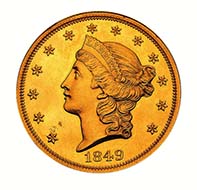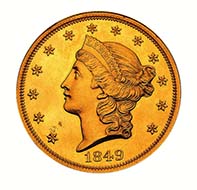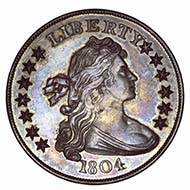June 9, 2011 – The American Numismatic Association’s signature Museum Showcase, featuring rare and historically significant numismatic treasures, will be on display at the 2011 ANA World’s Fair of Money (SM), Aug. 16-20 in Chicago. The showcase includes rarities from the Edward C. Rochette Money Museum, the Smithsonian Institution and private collections.
The Showcase, located on the bourse floor at the Donald E. Stephens Convention Center in Rosemont, will feature informative, museum-quality exhibits and include a 50-case exhibit exploring the financial and banking history of Chicago. Many exhibits will be accompanied by cell phone guided audio tours.
The Showcase, which made its debut at the 2010 ANA National Money Show (SM) in Fort Worth, is presented by the ANA at all of its conventions, and has grown larger and more impressive with each successive show.
Several rarities will make their Showcase debut in Chicago, including rare Chicago National Bank notes; a 1793 “Ameri.” large cent; an Eid Mar Denarius; the first Columbian Exposition commemorative half-dollar ever struck in proof, from the collection of the Field Museum; and astonishing collections of Gobrecht Dollars and German multiple thalers.
Following is a list of Museum Showcase exhibits to be displayed in Chicago. The ANA is also completing arrangements to display rare Colonial medals from Mexico.
1849 $20 pattern – Courtesy of the Smithsonian Institution’s National Numismatic Collection.
Good as Gold: America’s Double Eagles
This exhibit from the Smithsonian Institution explores the history of the U.S. $20 gold piece. The display features the first (1849 pattern) and last (1933) double eagles ever produced, and a 1907 Saint-Gaudens ultra-high-relief $20 pattern coin that President Theodore Roosevelt gave his daughter Edith for Christmas that year. Along with these, the key date 1927-D, and several other significant rarities, this exhibit features several of America’s most storied and valuable gold coins.
The Financial and Banking History of Chicago as Told Through its National Bank Notes
This 50-case exhibit will feature hundreds of National Bank notes from Chicago produced by every issuing bank and all charter periods. It illustrates the fascinating history of Chicago through the notes issued by local banks. Also included is a survey of National Bank notes from each county in Illinois.
1804 dollar, Idler/Bebee specimen – ANA collection.
The Idler/Bebee Class III Specimen 1804 Dollar
Known as “The King of U.S. Coins,” the 1804 dollar is exceedingly rare, with only 15 known examples. No U.S. dollars dated 1804 actually were struck that year; Type I specimens were struck in 1834-35 as diplomatic gifts (8 known), while Type II (unique) and III specimens (6 known) were struck during the 1850s for collectors. The Idler/Bebee specimen was donated to the ANA by Aubrey and Adeline Bebee in 1991.
1793 “Ameri.” Large Cent
Possibly the first cent ever produced by the United States, this coin is the finest known example of the “Ameri.” variety (“America” was abbreviated on the reverse legend). This coin was once part of the collection of Joseph Mickley, known as the “father of American coin collecting.” It is valued at more than $2 million. Courtesy of Bruce Moreland.
Columbian Exposition Half Dollar – the 1st United States Commemorative Struck
The World’s Columbian Exposition of 1893 celebrated the 400th anniversary of Christopher Columbus’ arrival in the new world in 1492, and had a huge influence on art, industry and architecture in the U.S. It was also the occasion of the first issuance of the first in a famous series of U.S. commemorative coins: the Columbian Exposition half dollars of 1892 and 1893. This is the first struck of those commemoratives, a piece that was purchased for $10,000, an astounding figure for the time. Visitors are encouraged to come and read the fascinating story of its history. Courtesy of the Field Museum, Chicago.
The Eid Mar Denarius
One of the most historically significant ancient coins, this coin was struck by Marcus Junius Brutus to commemorate the murder of Julius Caesar. The obverse has a portrait of Brutus while the reverse features a pileus (freedom cap) between two daggers, representing Brutus and Cassius, the leaders of the assassins, with the inscription “EID MAR” (Ides of March) below. Brutus and Cassius are portrayed as saviors of the Roman Republic. Courtesy of Michael Gasvoda.
German Multiple Thalers
In the 17th and 18th centuries, rulers in Germany issued some of the largest and most interesting coinage ever produced. These multiple thalers were first issued by Duke Julius (1528-89) of Brunswick-Wolfenbüttel, who planned to create a permanent reserve fund for the defense of his duchy. He ordered each of his subjects that owned property to purchase one of his new multiple thalers. The highlight of the display will be an enormous 10-thaler piece. Courtesy of Jon Subak.
The Historic Gobrecht Dollar
In 1835 Christian Gobrecht, an engraver at the U.S. Mint, was asked to prepare a set of dies for a new pattern dollar based on designs by Thomas Sully and Titian Peale. These coins were the first dollars to be issued by the U.S. Mint since 1804 and were struck in different design varieties and metals. Only 1,900 original Gobrecht dollars were struck dated 1836, 1837 or 1839, making these coins rare and interesting examples of numismatic history. This display will have 22 Gobrecht dollars in stunning condition, making this the most complete set of these coins ever displayed by the ANA. Courtesy of Bob R. Simpson.
The McDermott/Bebee Specimen 1913 Liberty Head “V” Nickel
This famous coin is one of five 1913 “V” nickels that were struck under mysterious circumstances at the Philadelphia Mint. The design for these coins was used from 1883-1912. In 1913 it was replaced by the Buffalo nickel design, but somehow five unauthorized “V” nickels were struck with the 1913 date. They were unknown by numismatists until 1919 when all five were displayed at an ANA convention, creating a sensation. This piece is from the ANA Money Museum collection and ranks as one of the most valuable of all U.S. coins.
For more information on the ANA World’s Fair of Money visit this site.






